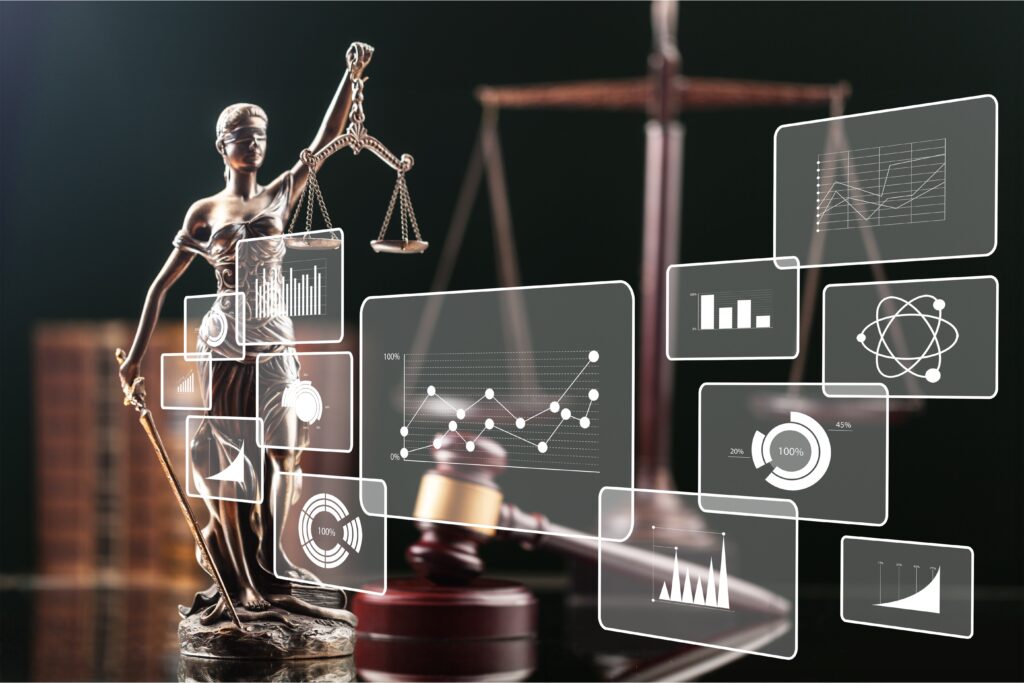Picture walking into your law office in 2015. You’d find attorneys poring over stacks of documents, paralegals manually reviewing contracts, and researchers navigating through countless legal databases.
Fast forward to 2025, and the landscape has transformed dramatically. Artificial intelligence now handles many of these tasks with remarkable efficiency, letting attorneys focus on higher-level strategy and complex problem-solving.
This guide will help you navigate the future of legal AI that will transform law practice in 2025 and beyond.
The Future of Legal AI: The Path Ahead
The evolution of AI in legal practice mirrors the development of a junior associate into a trusted colleague.
Early AI systems could handle basic tasks like document review and simple research, much like a first-year associate.
Today’s advanced systems can manage complex, multi-step legal processes with increasing autonomy, similar to how a seasoned associate might handle entire cases with minimal supervision.
AI Agents: Your New Digital Associates
AI agents in legal practice represent the next generation of legal technology, functioning as autonomous systems that can handle complex tasks and make decisions based on defined parameters. Unlike traditional legal software that follows rigid rules, these agents can:
- Conduct preliminary legal research across multiple sources and jurisdictions
- Draft initial documents based on specific requirements and precedents
- Monitor regulatory changes and proactively flag relevant updates
- Coordinate with other AI tools to complete complex workflows
- Learn from feedback to improve their performance over time
Practice Tip: When implementing AI agents, start with well-defined, routine tasks where success can be easily measured. This builds confidence in the technology while providing valuable training data for more complex applications.
Multi-Modal AI: Beyond Text Analysis
Today’s advanced AI systems can process multiple types of data simultaneously — text, images, audio, and video. This capability transforms how attorneys handle evidence, depositions, and court proceedings. For example, during a video deposition review, multi-modal AI can:
- Transcribe spoken testimony in real-time
- Analyze facial expressions and body language for credibility indicators
- Cross-reference statements with documentary evidence
- Flag potential inconsistencies across different types of evidence
- Generate comprehensive deposition summaries integrating all these elements
RAG Systems: Enhancing AI Reliability
Retrieval-Augmented Generation (RAG) addresses one of the most significant concerns about AI in legal practice: accuracy and reliability.
Think of RAG as giving your AI system access to a carefully curated law library it must consult before making any statements.
This technology:
- Verifies AI outputs against authoritative legal sources
- Incorporates firm-specific precedents and knowledge
- Provides traceable citations for generated content
- Maintains awareness of jurisdictional context
Knowledge Graphs: Building the Legal Mind
Legal Knowledge Graphs serve as the foundation for advanced legal AI, functioning like a vast, interconnected map of legal concepts, cases, and relationships.
Unlike traditional legal databases that store information in separate silos, knowledge graphs create meaningful connections between different pieces of legal information.
These sophisticated systems can:
- Map complex relationships between legal concepts, cases, and statutes
- Enable AI systems to understand legal principles and their applications
- Support nuanced legal reasoning across jurisdictions
- Automatically update as new legal developments occur
- Facilitate sophisticated legal analysis and research
Key Insight: Knowledge graphs transform legal research from simple document retrieval into sophisticated reasoning systems that can understand and apply legal principles across contexts.
The New Generation of Language Models
The latest generation of Large Language Models (LLMs) brings unprecedented capabilities to legal practice. These systems show sophisticated legal reasoning abilities that include:
- Analyzing complex legal scenarios across multiple jurisdictions
- Identifying relevant precedents and distinguishing cases
- Evaluating the strength of legal arguments
- Generating counter-arguments and alternative theories
- Predicting potential challenges and outcomes
Warning: The ABA Formal Opinion 512 (July 2024) reminds attorneys that while AI capabilities have advanced significantly and will continue to do so, lawyers remain responsible for ensuring competent use of the technology and maintaining diligence in legal work.
Virtual Reality and AI: The Future of Legal Practice
The integration of legal AI and virtual reality is creating immersive legal experiences that transform how attorneys prepare cases, interact with clients, and present in court.
This technology enables:
Advanced Trial Preparation
- Create detailed virtual recreations of incident scenes
- Practice presentations in realistic virtual courtroom environments
- Test strategies with AI-powered virtual juries
- Prepare witnesses through immersive simulations
- Analyze and improve presentation effectiveness
Enhanced Client Communication
- Conduct virtual meetings with real-time AI assistance
- Present complex legal concepts through interactive visualizations
- Enable remote document review and collaboration
- Facilitate virtual mediation and arbitration
Implementation Guide for Next Gen Legal AI
Successful deployment of advanced AI technologies requires careful planning and consideration of several key factors:
Technical Foundation
Your firm’s technical infrastructure must support:
- High-performance computing resources
- Secure data storage and processing
- Robust network capabilities
- Integration with existing systems
- Scalability for growth
Data Management Excellence
The effectiveness of AI systems depends heavily on data quality. Focus on:
- Establishing clear data governance frameworks
- Robust validation processes
- Creating standardized data formats
- Maintaining security and privacy
- Regular quality audits
What Attorneys Can Expect From AI
As we look toward the future, several key trends are emerging that will shape the evolution of legal AI:
Autonomous Legal Workflows
AI systems are increasingly capable of handling complete legal processes with minimal human intervention, particularly in:
- Contract management and review
- Regulatory compliance monitoring
- Due diligence processes
- Basic litigation document preparation
- Legal research and analysis
Enhanced Decision Support
Advanced AI technologies are evolving to provide sophisticated decision support through:
- Predictive analytics for case outcomes
- Risk assessment and mitigation strategies
- Resource allocation optimization
- Strategic planning assistance
- Cost and timeline projections
Conclusion: Embracing the AI-Enhanced Future of Law
We’re moving beyond questioning whether AI will transform legal work. It already has.
The real question facing legal professionals today is how to thoughtfully integrate these powerful tools while preserving the essential human elements of legal practice.
Think of these advanced AI technologies as a new layer in the legal profession’s foundation, much like how legal databases transformed research in the 1980s or how email revolutionized client communication in the 1990s. Just as those technologies didn’t replace legal expertise but enhanced it, today’s AI systems are amplifying, not supplanting, the attorney’s judgment, creativity, and strategic thinking.
The key to success lies in understanding that AI excellence and legal excellence are not competing goals but complementary ones.
The most successful law firms in 2025 and beyond will be those that master the art of combining human legal expertise with AI capabilities. This means developing workflows where AI handles routine analysis and processing, freeing attorneys to focus on high-level strategy, complex problem-solving, and the inherently human aspects of legal practice like client counseling and courtroom advocacy.
As we look ahead, it’s clear that proficiency with advanced AI technologies will become as fundamental to legal practice as legal research skills.
Yet this transition doesn’t reduce the importance of traditional legal skills — it elevates them. In an AI-enhanced legal environment, deep legal knowledge, ethical judgment, and strategic thinking become even more important as they guide and contextualize AI outputs.
The future of legal practice isn’t about choosing between human expertise and artificial intelligence. It’s about creating a synergy between the two.
By embracing these technologies while maintaining our professional standards and ethical principles, we can create a legal system that is more efficient, accessible, and just than ever before.
Frequently Asked Questions
Q. How can I ensure AI systems maintain client confidentiality?
A. Implement strong data encryption, access controls, and regular security audits. Choose AI providers with clear data protection policies and avoid using public AI systems for sensitive information.
Q. What’s the best way to start implementing advanced AI in a small law firm?
A. Begin with well-established use cases like document review or legal research. Choose cloud-based solutions to reduce infrastructure costs and gradually expand based on success and need.
Q. How do knowledge graphs improve legal research compared to traditional databases?
A. Knowledge graphs create connections between legal concepts, enabling more sophisticated analysis and understanding of relationships between cases, statutes, and legal principles.
Q. What training do lawyers need to effectively use these advanced AI systems?
A. Lawyers need training in AI capabilities, limitations, ethical considerations, and practical implementation. Regular updates and continuing education are essential as technologies evolve.
Q. How can firms measure the ROI of implementing advanced AI technologies?
A. Track metrics like time saved, accuracy improvements, client satisfaction, and new business generated. Compare these against implementation and ongoing costs.
Q. What ethical considerations should firms address when implementing AI?
A. Consider issues of bias, transparency, accountability, and maintaining attorney competence. Ensure compliance with relevant bar associations’ AI guidelines.
Q. How can firms ensure the accuracy of AI-generated legal work?
A. Implement verification protocols, use RAG systems, maintain quality control processes, and ensure proper human oversight of AI outputs.





